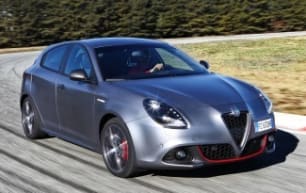Though it has been modified by what may be an almost unrecognisable amount by Maserati’s engineers, using Stellantis’ Gorgio architecture that first appeared in the magnetic Alfa Romeo Giulia of 2016 and then utterly seduced in the flagship Quadrifoglio version is a great place to start.
Now, we’ve only tested the all-new GranTurismo (GT from here on in) coupe around the fast and challenging Tailem Bend race track near Adelaide, so cannot speak of its behaviour on Australian public roads.
But what we experienced was an incredible and elevating sports car experience. And, yes, that's despite the loss of the magnetic Ferrari-based 4.7-litre V8.
Even with ‘just’ 365kW of power and 600Nm of torque, the base Modena twin-turbo V6 thunders off the line, its superb ZF eight-speed automatic transmission, surely the best of its type in the world, shifting with lightning speed through the ratios as it blitzed past 100, then 150, then 200km/h in mere seconds. Maserati says within 8.8s, in fact.
To help keep all that in check, the GranTurismo deploys double wishbones up front, a multi-link independent rear suspension set-up, along with the aforementioned air suspension – which is a nice nod to history as French carmaker Citroen used to own Maserati.
Anyway, the active suspension works in tandem with the four self-explanatory driving models fitted – 'Comfort', the default 'GT', 'Sport' and 'Corsa' (track).
We were too thrilled to notice whether the loss of the Maserati V8 grumble, because the exhaust howl was exciting enough, along with the sheer ease in which the GT accelerates.
And when we needed to suddenly brake reaching corners that seemed stupidly close until we realised they weren’t, we also were relieved at the Modena’s marvellously effective Brembo brake package.
Now, at under 1900kg, the GT is still a heavy car, but not for a five-by-two metre-long-and-wide 2+2 seater coupe.
Seriously, the cohesion and crispness of the steering, whether in Comfort or three-settings down in shockingly heavier Corsa mode, tingles the senses, seeming far lighter and more agile than the (albeit lithe) luxury coupe styling suggests.
Not Porsche 911 supernatural-alacrity, but beautifully quick and reactive nonetheless. It’s such a buzz.
There’s also a sense of isolation from the air suspension underneath, aided by the trick adaptive dampers doing their bit too to cushion the ride. The vital luxury part of the GT equation is omnipresent in the Maserati coupe.
And this was all just in the Modena. Another few laps in the Trofeo just sharpened the senses and speed and responses, supercharging the experience around Tailem Bend.
What all this left us is a longing for more time behind the wheel. Which hopefully will happen soon, but for now, this is far-and-away the best Maserati I have ever driven. If you can afford one, this is all great news.
Of course, back in the real world on everyday roads, there will surely be criticisms, but for now, around the circuit, the GranTurismo is something very special indeed.

